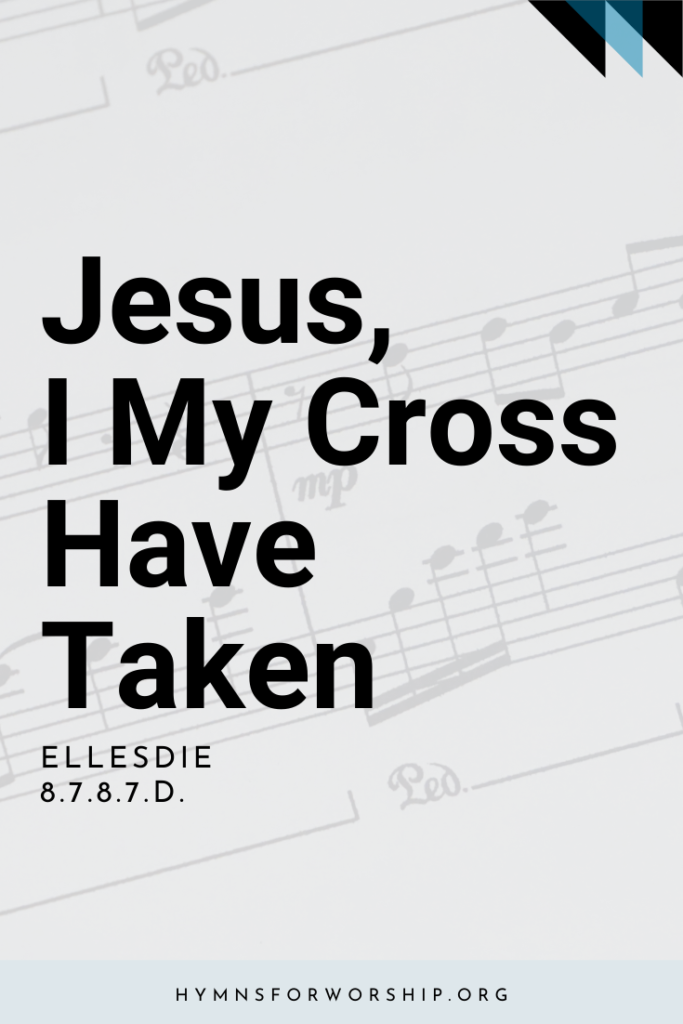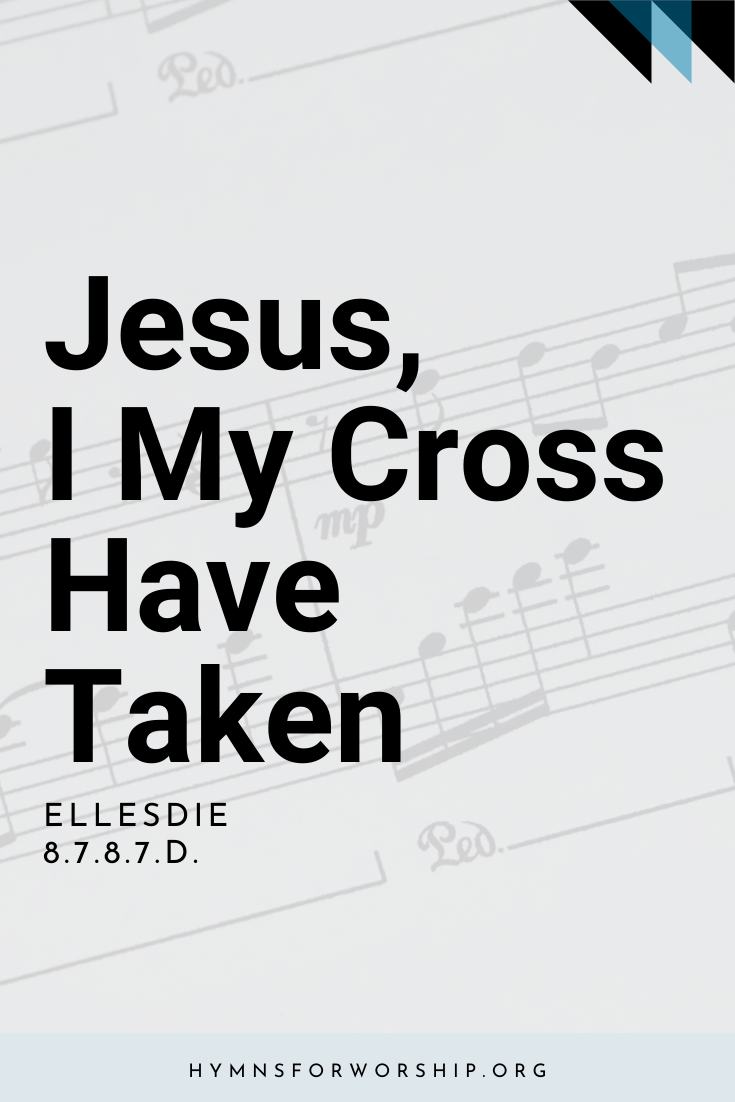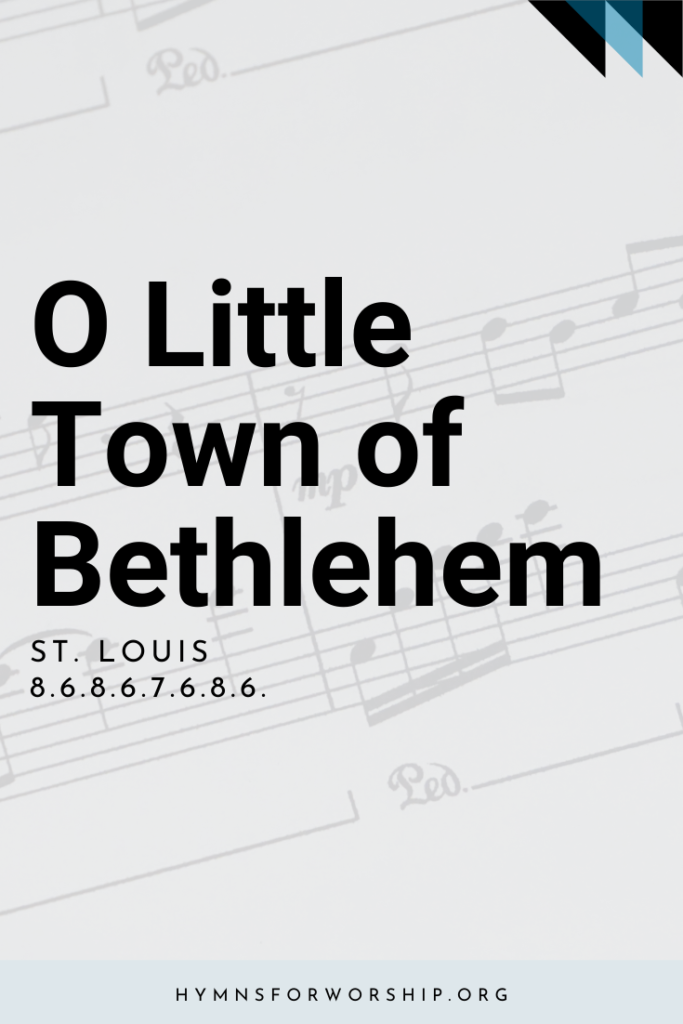GOSPEL >> Consecration
SDAH 325
Jesus, I my cross have taken,
all to leave and follow Thee.
All things else I have forsaken,
Thou from hence my all shall be.


Text
1
Jesus, I my cross have taken,
all to leave and follow Thee.
All things else I have forsaken,
Thou from hence my all shall be.
Perish every fond ambition,
all I’ve sought or hoped or known.
Yet how rich is my condition!
God and Heaven are still mine own.
2
Let the world despise and leave me,
they have left my Savior, too.
Human hearts and looks deceive me;
Thou art faithful, Thou art true.
O, ‘tis not in grief to harm me,
while thy love is left to me;
O, ‘twere not in joy to charm me,
If that love be hid from me.
3
Soul, then know thy full salvation;
rise o’er sin, and fear, and care;
Joy to find in every station
something still to do or bear:
Think what Spirit dwells within thee;
Think what Father’s smiles are thine;
Think that Jesus died to win thee,
child of heaven, canst thou repine?
4
Haste then on from grace to glory,
armed by faith, and winged by prayer,
Heaven’s eternal day’s before thee,
God’s own hand shall guide thee there.
Soon shall close thy earthly mission,
soon shall pass thy pilgrim days;
Hope soon change to glad fruition,
faith to sight, and prayer to praise.

Hymn Info
Biblical Reference
(a) Mark 10:28 (b) Isa 53:3; Rev 19:11 (c) 1 Thess 5:10 (d) Ps 48:14
Author
Henry F. Lyte (1793-1847)
Year Published
1824
Hymn Tune
ELLESIDE
Metrical Number
8.7.8.7.D.
Arranged
from Mozart by Hubert P. Main (1839-1926)
Year Composed
1873
Hymn Score
Piano Accompaniment
Notes
Get to know the hymns a little deeper with the SDA Hymnal Companion. Use our song leader’s notes to engage your congregation in singing with understanding. Even better, involve kids in learning this hymn with our homeschooling materials.
This poem appeared over the signature “G” in Sacred Poetry, Edinburgh, 1824, under the title “Lo! We Have Left All and Followed Thee.” It was picked up by James Montgomery in his Christian Psalmist, 1825, and then in two other books without signature. In a slightly different form it appears in Poems, Chiefly Religious, 1833, which was written by Henry Francis Lyte (1793 – 1847; see SDAH 4) and dedicated to Lord Farnham; Lady Farnham, who died just before publication, had suggested that Lyte’s poems be printed. The hymn appears under the same title, which is a quotation in Mark 10:28 and consists of six stanzas of eight lines each.
The theme of the hymn fits the experience of Anne Maxwell, daughter of an Anglican clergyman, who was forced to leave her home because she joined the Methodist Church. Later she married Lyte, an Anglican curate! Lyte also wrote SDAH 4, “Praise, My Soul, the King of Heaven”; SDAH 25, “Praise the Lord, His Glories Show”; and SDAH 50 “Abide With Me.”
ELLESDIE is said to come from Wolfgang Amadeus Mozart (1756-1791). Is was published in 1831 with two parts only, a melody and a bass; Hubert Platt Main (see SDAH36) completed the harmony in 1873. ELLESIDIE is also uses for SDAH 621, “Gracious Father, Guard Thy Children.” Main also arranged SDAH 36, BELOVED, and composed SDAH 456, “My Lord and I.”
Mozart was born January 27, 1756, at Salzburgh, Astria, with the full name Joannes Chrysostomus Wolfgang Theophilus. On the certigicate his father wrote Gottlieb (beloved of God), instead of Theophilus, which finally was charged to the Latin form Amadeus. In private life he was always called Wolfgang, Recognized as one of the greatest musical geniuses of the Western world, he began learning harpsichord and piano at the age of 3 from his father and sister; at age 6 he made a concert tour with them to Munich and Vienna. People were astounded at his ability to improvises, and “all the ladies lost their hearts to the little fellow.” The next year they tool a longer trip through Germany and Belgium to Paris, where they stayed five months. They went on to London and triumphant concert for royalty. The king put before Wolfgang pieces by J.C. Bach, Able, and Handel, which he played perfectly at sight. Throughout his life he was widely feted as a performer, composer, and conductor, but somehow never achieved financial security. He died December 5, 1791, in Vienna, Austria, at the young age of 35. And was buried in a pauper’s grave. Kochel’s catalog of Mozart’s compositions records some 600 works, very few of which were published in his lifetime, but were circulated freely in manuscript form. Almost all of his vast output has been preserved, however, in the edition published by Breitkopf and Hartel. The catalog includes operas; all kinds of church music for organ, choir, and instruments; solo arias with orchestra; a cappela vocal music; songs with piano; concerts for violin and piano with orchestra at least 41 symphonies; chamber music and works for piano and harpsichords. Starting with a piano work at age 4, his life was consumed with music and composition, ending with the beautiful Requiem, which was unfinished at his death. For the most part, his creative process was completed in his mind before putting pen to paper. His thoughts were always occupied with music. He once wrote to his father, “You know that I am, so to speak, swallowed up in music, that I am busy with it all day, speculating, studying, considering.” Mozart cannot really be considered a hymn tune composer, as all the ones credited to him have been adapted from his other works.






